Matcha Salt Is The Simple Blend You'll Want To Put On Everything
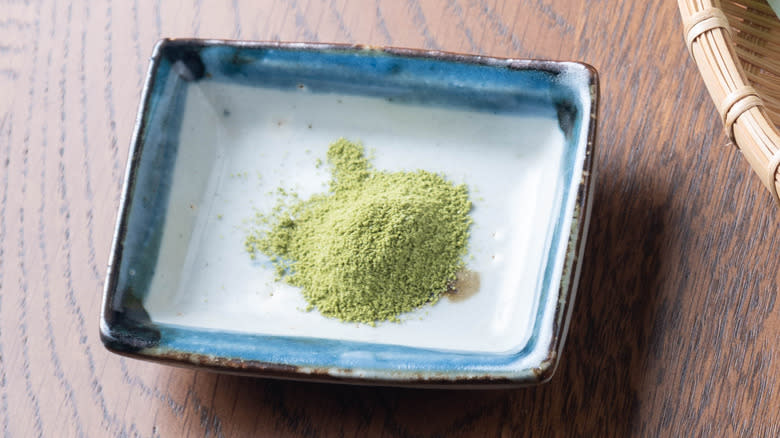
We may receive a commission on purchases made from links.
Matcha is often associated with pretty green drinks, from matcha lattes to matcha smoothies. However, you might be surprised to learn that the green powder can be enjoyed as a seasoning too. Enter matcha salt, also called green tea salt, a Japanese seasoning that's used to flavor savory and sweet foods alike.
If you've only experienced matcha powder in the form of a beverage, the idea of using matcha powder in cooked recipes might sound unusual — let alone combined with salt. But when you consider the flavor profile of matcha, it's not surprising that it works well with salt's intensity. Specifically, matcha has a strong herbal taste that complements the vibrant flavor of salt, making the combination perfect for unexpected ways to use matcha.
But first, you might be wondering what's the difference between matcha and green tea. While matcha is produced from the same plant as traditional green tea, for matcha the leaves are grown in the shade before being dried and ground into a powder that is directly mixed into drinks. Green tea, on the other hand, consists of leaves grown in sunshine, which are steeped in hot water and removed from the drink, providing an infusion of nutrients and flavor. So, be sure to use matcha powder — not regular green tea leaves — to make matcha salt. Here's a detailed guide to matcha salt, plus tips on how to use the seasoning in your own cooking.
Read more: 13 Unexpected Ingredients To Elevate Lasagna
What Is Matcha Salt?
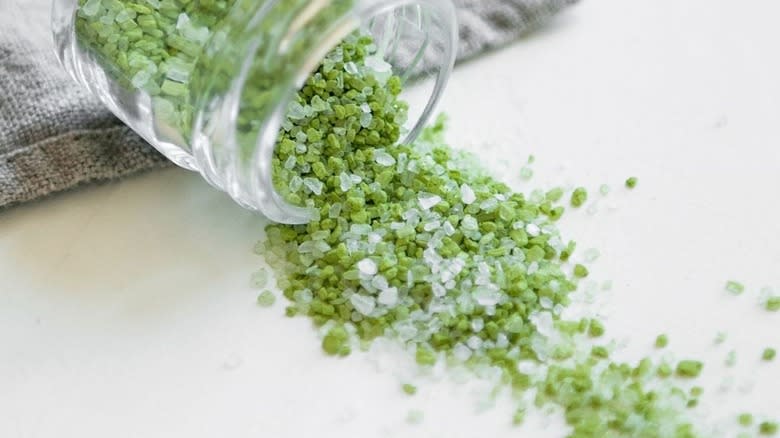
As the name suggests, matcha salt is made of matcha powder and salt. If you're unfamiliar with matcha, it's a type of powdered green tea with Asian origins. The green tea leaves — which contain caffeine — are steamed before being ground up, resulting in a bright green powder. It also has an earthy, bitter flavor with a hint of umami. Meanwhile, salt is a mineral that's used worldwide as a seasoning and preservative. Matcha salt is traditionally made with fine sea salt, but chunky or flaky salt varieties can be used for a different texture. Kosher salt or Himalayan salt can also be used in the seasoning.
The process for making matcha salt is simple: matcha powder and salt are thoroughly mixed together, so that the salt crystals are coated in the green powder. The easiest method is to combine these ingredients in a bowl and stir until the salt is fully coated. Alternatively, matcha and salt can be ground together with a mortar and pestle or spice grinder to make the seasoning smoother.
How Is Matcha Salt Different From Regular Salt?

Matcha salt and salt are both used to flavor foods. However, the ingredients have major differences that are worth considering when using them together in one blend. Matcha salt is green from the matcha powder, while salt typically has a plain white color. Thus, when used on food, matcha powder will be prominently noticeable due to its vivid color. Regular salt tends to blend in with other ingredients, especially if it has a fine texture, but matcha salt will impart its green color to any dish.
As you can imagine, matcha salt and salt both taste salty. But due to the addition of matcha powder, the saline flavor of matcha salt is quite different. Rather than being a prominent taste, the saltiness is toned down due to the bitter, umami notes of matcha powder. Naturally, pure salt has a more intense saltiness.
Another noteworthy difference between matcha salt and regular salt lies in the former's caffeine content. As a derivative of green tea leaves, matcha powder contains caffeine, which stimulates the body and mind. In contrast, salt is caffeine-free. While a sprinkle of matcha salt won't contain a lot of caffeine, it's worth keeping this in mind if you're extra-sensitive to caffeine or prefer to skip it altogether.
What Does Matcha Salt Taste Like?
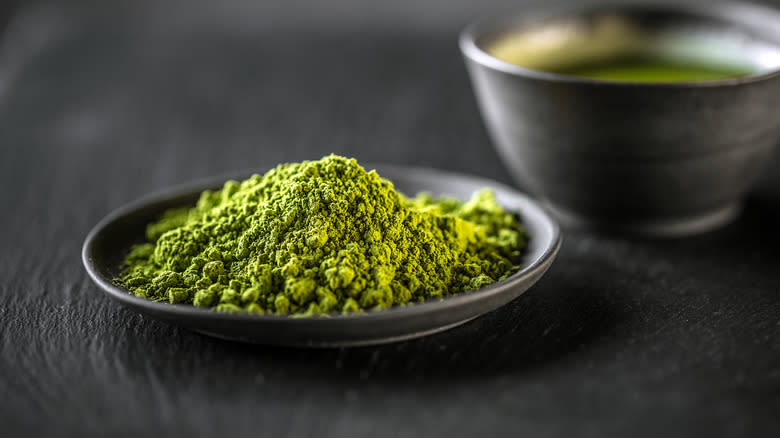
Matcha salt offers a unique medley of flavors that will surely tantalize your taste buds. The salt lends its briny, bright, and sharp flavor, while the matcha boasts a bitter, umami-tinged taste. When combined, matcha's bitterness is toned down by the salt, while the umami notes are amplified.
The flavor of matcha salt might differ slightly depending on the variety of salt used. For example, sea salt has trace minerals, so it has a more dynamic flavor than regular table salt. Similarly, Himalayan salt has a more complex taste than table salt, which may be noticeable if it's used to make matcha salt. The crystals in Himalayan salt also tend to be bigger than other types of salt, which makes the saltiness more noticeable.
Make sure to use fresh matcha powder for the best-tasting matcha salt. Matcha powder does expire, and the older it is, it will have a less potent flavor. You can tell matcha powder is expired if its green color has become dull.
How To Cook With Matcha Salt

After you've mixed up a batch of matcha salt or purchased a container of it, you might be wondering just how to use matcha salt with varied dishes. Luckily, this seasoning is extremely versatile, so you'll have no problem finding opportunities to use it. The main factor to keep in mind is that matcha salt, unlike regular salt, isn't meant to be added to recipes during the cooking process. Instead, matcha salt should be added to finished dishes or cooked foods as a condiment.
A common way to use matcha salt is on top of plain rice. You can enjoy the rice on its own as a side dish, or combined with protein and vegetables. It's also delightful on top of eggs, tofu, or deep-fried tempura, a Japanese dish of battered and deep-fried vegetables or seafood. For a simpler take, sprinkle it on top of ice cream, plain popcorn, avocado toast, or chips. You can even try it on fresh fruit, as the salt will amplify the natural sweetness. Essentially, matcha salt can be used anywhere you'd like a salty, earthy flavor and a dash of bright green color.
Where To Buy Matcha Salt
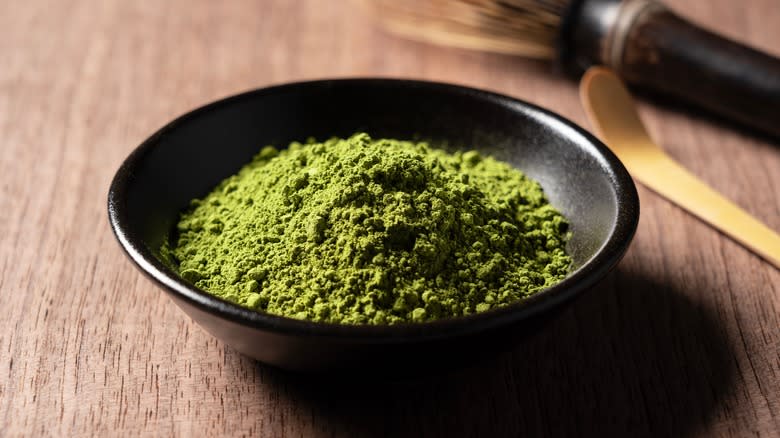
In the U.S., matcha salt is not as common as other seasoned salt varieties, so you may not find it in a typical supermarket — though it's worth checking the Japanese or Asian section of your grocery store's international aisle. Otherwise, you can find matcha at tea shops, specialty spice shops, and Japanese or Asian markets. Health stores might also carry matcha in the spice section. You can buy it online as well, including on Amazon and websites for spice and tea shops.
When shopping for matcha salt, take a minute to check the ingredients list. A good-quality matcha salt will have only two ingredients: matcha powder and salt. Additionally, if you prefer a specific type of salt, consult the label to ensure you're getting the one you'd like. Finally, matcha salt is also called green tea salt, so keep this in mind when searching for the seasoning.
Purchase matcha salt at Suraj Spices and Teas for $4 per ounce.
Purchase matcha green tea salt at Spice Station for $3.50 per ounce.
Purchase Gustas Vitae Green Tea Sea Salt on Amazon for $7.66.
Nutritional Information About Matcha Salt
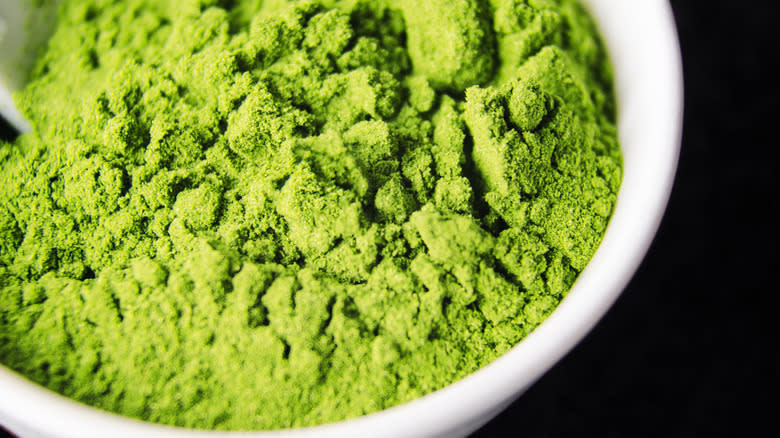
On its own, matcha powder is packed with antioxidants, which fight potentially harmful free radicals in the body. When present in high amounts, free radicals may lead to oxidative stress, which can damage healthy cells over time, increasing the risk of disease.
Matcha powder is rich in plant compounds called catechins, which provide exceptional antioxidant properties. Since matcha salt contains matcha powder, it will add some antioxidants to your food. However, as the salt is used in small amounts, it won't provide as many antioxidants as drinking a matcha latte.
Salt, including seasoned salts like matcha salt, should be consumed in moderation. That's because eating too much salt will increase your intake of sodium, which can potentially raise your blood pressure and increase the likelihood of heart disease or stroke. If you'd like to limit your intake of salt for personal or health reasons, be mindful of how much matcha salt you add to foods.
Varieties Of Matcha Salt
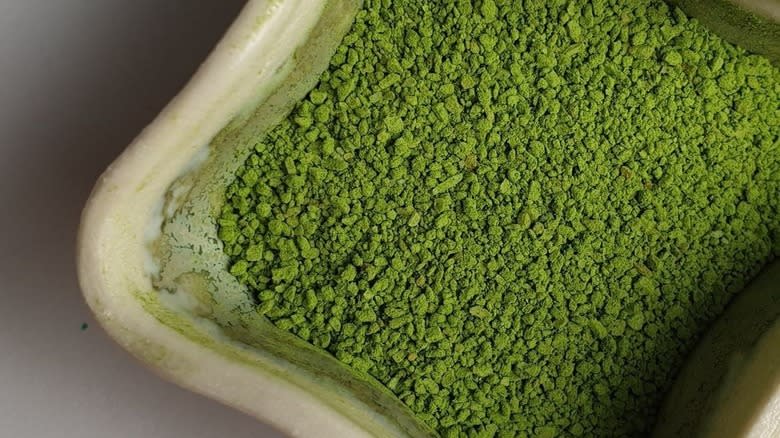
Although matcha salt typically contains just two ingredients, there are several varieties available. For example, depending on the type of salt used, matcha salt can have a fine or chunky texture. Finer salts are best for coating foods, like popcorn and chips, as the smaller granules will easily cling to the item. In contrast, a chunkier matcha salt will work well as a garnish, especially on foods like deep-fried tempura, eggs, or ramen.
Some matcha salt products might contain types of seaweed powder. These options may have a more intense briny and umami flavor, as well as a deeper green color. If you're not a fan of seaweed, or you have a seaweed allergy, be sure to check the product's label before purchasing it. Additionally, if you decide to make matcha salt at home, different recipes might call for other seasoning ingredients. Examples include black pepper, garlic powder, or lemon peel powder, all of which add extra flavor.
How To Store Matcha Salt
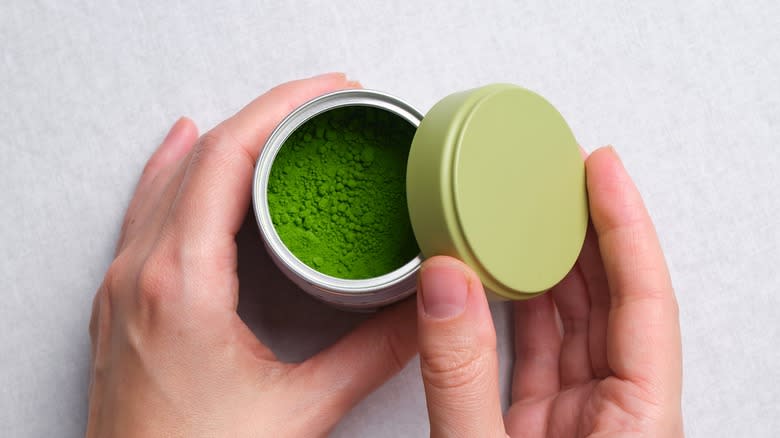
When storing matcha salt, protecting the quality of the matcha powder is of paramount importance. That's because salt generally has a long shelf life, while matcha powder is more delicate. It tastes best when used within the first month of opening the package, and it's sensitive to humidity and light. Both elements can degrade the quality of the matcha, resulting in a less flavorful and colorful product.
With that in mind, matcha salt can be stored in an airtight container in a cool, dark pantry for up to three months. You can also keep it in the refrigerator to preserve it even better. The cool temperature and lack of sunlight will ensure that the matcha powder stays fresh. If you've purchased matcha salt from a retailer, check the label for storage instructions, as the exact recommendations might be different.
Furthermore, if you'd like to make your own matcha salt, try to use the freshest matcha you can find. This ensures that your matcha salt — and future dishes topped with it — will have the optimal flavor and quality.
Read the original article on Tasting Table.


